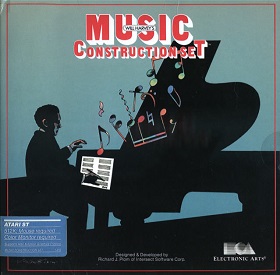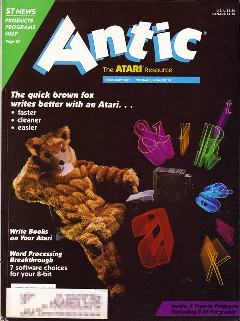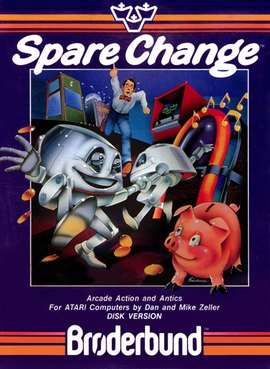Related Research Articles

VisiCalc is the first spreadsheet computer program for personal computers, originally released for Apple II by VisiCorp on October 17, 1979. It is considered the killer application for the Apple II, turning the microcomputer from a hobby for computer enthusiasts into a serious business tool, and then prompting IBM to introduce the IBM PC two years later. More than 700,000 copies were sold in six years, and up to 1 million copies over its history.

The Atari 8-bit computers, formally launched as the Atari Home Computer System, are a series of 8-bit home computers introduced by Atari, Inc. in 1979 with the Atari 400 and Atari 800. It is the first home computer architecture with coprocessors, enabling more advanced graphics and sound than most of its contemporaries. Video games are key to its software library, and the 1980 first-person space combat simulator Star Raiders is considered the platform's killer app.
The Print Shop is a desktop publishing software package originally published in 1984 by Broderbund. It was unique in that it provided libraries of clip art and templates through a simple interface to build signs, posters and banners with household dot-matrix printers. Over the years, the software has been updated to accommodate changing file formats and printer technologies.

Fantavision is an animation program by Scott Anderson for the Apple II and published by Broderbund in 1985. Versions were released for the Apple IIGS (1987), Amiga (1988), and MS-DOS (1988).

Will Harvey's Music Construction Set (MCS) is a music composition notation program designed by Will Harvey for the Apple II and published by Electronic Arts in 1983. Harvey wrote the original Apple II version in assembly language when he was 15 and in high school. MCS was conceived as a tool to add music to his previously published game, an abstract shooter called Lancaster for the Apple II.
Cut & Paste is a word processor published in 1984 for Apple II series, Atari 8-bit computers, Commodore 64, IBM PC compatibles, and IBM PCjr. It is one of the few productivity releases from game developer and publisher Electronic Arts, along with the contemporaneous Financial Cookbook. In the UK it was distributed by Ariolasoft.
Optimized Systems Software (OSS) was a company that produced disk operating systems, programming languages with integrated development environments, and applications primarily for Atari 8-bit computers. The founders of OSS previously developed Atari DOS, Atari BASIC, and the Atari Assembler Editor for Atari, Inc., and many OSS products are substantially improved versions. OS A+ and DOS XL are based on Atari DOS. BASIC A+, BASIC XL, and BASIC XE are based on Atari BASIC. EASMD and MAC/65 are modeled on the Atari Assembler Editor. Action! is an ALGOL-inspired compiled programming language with an integrated full-screen editor. OSS also sold some software for the Apple II.

AtariWriter is a word processor program for the Atari 8-bit computers released by Atari, Inc. as a 16 kB ROM cartridge in 1983. The program was fast and easy to use, while still allowing for the creation of fairly complex documents. It was a success for the platform, with at least 800,000 units initially sold, not including international versions and later updates.

SpeedScript is a word processor originally printed as a type-in MLX machine language listing in 1984-85 issues of Compute! and Compute!'s Gazette magazines. Approximately 5 KB in length, it provided many of the same features as commercial word processing packages of the 8-bit era, such as PaperClip and Bank Street Writer. Versions were published for the Apple II, Commodore 64 and 128, Atari 8-bit computers, VIC-20, and MS-DOS.

Antic was a print magazine devoted to Atari 8-bit computers and later the Atari ST. It was named after the ANTIC chip in the 8-bit line which, in concert with CTIA or GTIA, generates the display. The magazine was published by Antic Publishing from April 1982 until June/July 1990.Antic printed type-in programs, reviews, and tutorials, among other articles. Each issue contained one type-in game as "Game of the Month." In 1986, STart magazine was spun off to exclusively cover the Atari ST line.

Microsoft Write is a basic word processor included with Windows 1.0 and later, until Windows NT 3.51. Throughout its lifespan it was minimally updated, and is comparable to early versions of MacWrite. Early versions of Write only work with Write Document (.wri) files, which are a subset of the Rich Text Format (RTF). After Windows 3.0, Write became capable of reading and composing early Word Document (.doc) files. With Windows 3.1, Write became OLE capable. In Windows 95, Write was replaced with WordPad; attempting to open Write from the Windows folder will open WordPad instead.
Synapse Software Corporation was an American software developer and publisher founded in 1981 by Ihor Wolosenko and Ken Grant. Synapse published application software and developer tools and was primarily known for video games. It initially focused on the Atari 8-bit computers, then later developed for the Commodore 64 and other systems. Synapse was purchased by Broderbund in late 1984 and the Synapse label retired in 1985.

Volkswriter is a word processor for the IBM PC written by Camilo Wilson and distributed by Lifetree Software, Inc.

pfs:Write was a word processor released by Software Publishing Corporation (SPC) in 1983 for IBM PC compatible computers running MS-DOS/PC DOS, and the Apple II. It includes the features common to most word processors of the day, including word wrapping, spell checking, copy and paste, underlining, and boldfacing, with a few advanced features, such as mail merge and some others. The software was easier to learn and to use than more expensive software with more features such as WordPerfect, Microsoft Word, and XyWrite.
Bank Street Music Writer is an application for composing and playing music for the Atari 8-bit family, Apple II, Commodore 64 and IBM PC. It was written by Glen Clancy and published by Mindscape. The original Atari version, developed under the name "Note Processor", was released in 1985 and uses the computer's on-board sound chip to produce four-voice music recordings. The Commodore 64 version also uses that system's sound hardware, while the Apple and IBM PC versions require a sound card which was included in the retail box, or alternately use the three-voice sound chip standard with all Tandy and IBM PCjr computers.

Many games, utilities, and educational programs were available for Atari 8-bit computers. Atari, Inc. was primarily the publisher following the launch of the Atari 400/800 in 1979, then increasingly by third parties. Atari also distributed "user written" software through the Atari Program Exchange from 1981 to 1984. After APX folded, many titles were picked up by Antic Software.

1st Word is a word processor program for the Atari ST developed by GST Computer Systems and published in 1985. It was given away with all ST systems from December 1985 for the next two years. Although it was relatively well received, it was a very simple program, lacking most power features and was very slow when working in large documents. In spite of any limitations, its wide availability made the program's .DOC file format became a de facto standard for the platform and was widely supported by other programs like desktop publishing systems.

Spare Change is an action game designed by Dan and Mike Zeller and published in 1983 by Broderbund for the Apple II and Atari 8-bit computers. A Commodore 64 version was written by Steven Ohmert and released the same year. Ports for FM-7 and Sharp X1 were released in 1985. The difficulty of Spare Change can be customized through seven settings at the "Zerks Control Panel".

A.E. is a fixed shooter written by Jun Wada and Makoto Horai for the Apple II and Atari 8-bit computers and published by Broderbund in 1982. Versions followed for the VIC-20 (1983) and MSX (1984). Unlike most earlier shooters which have a solid color or starfield as a background, the action in A.E. takes place in front of science fiction scenes. Attacking creatures emerge from points in the image, often appearing to come from behind objects. Combined with a slight scaling as they advance, there is the impression of depth.

Atari Word Processor is a word processor program for the Atari 8-bit computers, announced by Atari, Inc. in January 1981 and shipped that summer. The program was powerful for its era, including numerous features like superscripts and two-column layouts. It was also quite complex, with a long list of control keys for basic operations and text-based menus for more complex ones. It left little memory free after loading, so longer documents had to be stored as separate files of about a page each and printing demanded a long re-formatting process as they were stitched together.
References
- ↑ "In the beginning, there was the word processor". ZDNet. Retrieved 2022-06-03.
- ↑ Saxon, Wolfgang (November 30, 1997). "Richard Ruopp, 65; Led Bank Street College". The New York Times .
- ↑ "Bank Street Writer". PC Magazine . 15 May 1984.
- ↑ "Softsel Hotlist Charts Biggest Hits in Software and Hardware". Chicago Tribune . March 20, 1988.
- ↑ Softsel/Merisel Company Profile
- ↑ Ciraolo, Michael (Oct–Nov 1985). "Top Software / A List of Favorites". II Computing. p. 51. Retrieved 28 January 2015.
- ↑ "Words at the Flick of a Key". Time . March 14, 1983.
- ↑ Leyenberger, Arthur (July–August 1983). "Bank Street Writer". ANALOG Computing . pp. 125–126.
- ↑ "The Bank Street Writer". Antic . September 1983.
- ↑ Gingras, Daniel J. (December 1984). "Low-cost Word Processing on the Apple". Byte . pp. A30–A37.
- ↑ Bobo, Ervin (August 1987). "Review: Bank Street Writer Plus". Compute!: 56.
- ↑ "InfoWorld Mar. 5 1984". 5 March 1984.
- ↑ "Bank Street Writer". PC Magazine. January 28, 1986.